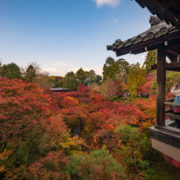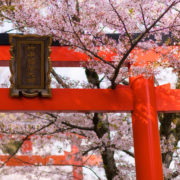Toji Temple Review & Tips
Toji Temple (東寺, Tōji) is one of Japan’s UNESCO World Heritage Sites, and is located within walking distance of Kyoto Station. It’s famous for having the tallest pagoda in Japan, and that’s why most visitors are drawn to Toji. In this review, we’ll share info and our thoughts on visiting, including whether it’s worth the time and money.
Toji Temple is considered Kyoto’s “East Temple” and was founded in 796, at the outset of the Heian Period just two years after Kyoto became Japan’s capital. Together with the now defunct Saiji Temple (“West Temple”), it formed Kyoto’s “Guardian Temples” that marked the south entrance to the city.
Perhaps most notably, it was known as Kyō-ō-gokoku-ji (教王護国寺), or The Temple for the Defense of the Nation by Means of the King of Doctrines), which indicates that it provided defense for the city. These sister East and West Temples also stood alongside Kyoto’s Rashomon gate, the ruins of which are famously the setting for Akira Kurosawa’s influential film by the same name, which ranks among the greatest films of all-time, and is a must-see before you visit Japan…
There’s an ebb and flow to Toji Temple’s history, with its significance in Kyoto rising and falling over time. The temple began its first decline towards the end of Heian period, but had its prominence restored with the rise of Kōbō Daishi, who was appointed head priest of Toji Temple.
During that time, Toji Temple became one of the most important Shingon temples. Kōbō Daishi is also responsible for the temple’s (literal) growth, as many buildings were constructed while he was head priest.
These include Toji’s five-story pagoda, which was originally erected in 826. This pagoda is the tallest pagoda in all of Japan, and is Toji Temple’s iconic draw. It can be seen throughout Kyoto, and is one of the symbols of the city.
It’s this pagoda this also beacons tourists to Toji Temple, making it one of Kyoto’s more popular points of interest.
In addition to the pagoda, Toji Temple has a number of other structures, including Kondo Hall, which is the temple’s main hall and largest building. After being destroyed by fire, this hall was reconstructed in the Edo Period with a then-contemporary architecture style.
Kondo Hall houses Toji’s main object of worship, which is a large wooden statue of Yakushi Buddha, who is flanked by his two attendants, the Nikko and Gakko Bodhisattvas.
Another Kobo Daishi addition is Kodo Hall, which served as the temple’s lecture hall. Also destroyed by fire, this was rebuilt in its original architectural style.
Today, Kodo Hall houses 19 statues imported from China with Dainichi Buddha (Vairocana) at the center, surrounded by buddhas, bodhisattvas, and the fearful and guardian kings.
Also outside these areas, you’ll find Miedo Hall (Founder’s Hall) with a statue of Kobo Daishi. In this area, you can also visit Homotsukan Museum, which displays several large Buddhist statues and other important artifacts. It’s essentially an extension of Toji Temple, but its hours are limited.
Now comes the question of whether Toji Temple is worth your time. Given that it’s only a 20 minute walk from Kyoto Station (a place you’ll undoubtedly find yourself while visiting), I’d say yes. Seeing the pagoda up close is a must-do.
We should note that despite the relatively short walk, Toji Temple can be surprisingly difficult to incorporate into Kyoto itineraries. There’s really nothing else around it, and accessing it via public transportation can be frustrating–and usually require a transfer. That’s why we usually just walk from Kyoto Station.
Whether it’s worth the money is also not a simple question. In essence, Kobo Hall and Kondo Hall are what you’re paying ~$5 to access, as the pagoda is perfectly visible from outside the paid areas.
I know, it might seem silly to make the effort to visit a temple without actually going inside, but that pagoda is the main draw, and (most of the time) you can’t go inside it anyway.
Plus, there are a ton of temples to see in Kyoto, and with an “meh, it’s only $5” attitude, your expenses will quickly snowball.
Since first publishing this review, we’ve revisited Toji Temple during both spring sakura and fall cherry blossom seasons. It’s definitely worth the money during both fall colors and cherry blossom seasons, day or night–but particularly for a nighttime illumination.
While the cost of the separately-ticketed nighttime illuminations is on the steep side (ranging in price from 800 to 1,300 yen depending upon the event and which option you choose–see the official rate chart), it does include access to pretty much everything, including the ground level of the pagoda’s interior, plus the Homotsukan and Shoshibo are open for special public viewing. Moreover, the lighting at Toji Temple is spectacular, making for some incredibly photogenic scenery.
Any other time of the year, it really comes down to if you want a ‘Buddha statue fix.’ We’ve seen much of the same types of thing in other temples, and on a grander scale–in Kyoto, Sanjusangendo Temple is a superior alternative in that regard. Nevertheless, Toji Temple offers a stunning pagoda, and the temple’s grounds are absolutely stunning in both spring and fall. Whether it’s worth your money and time will likely hinge upon what time of year you visit, and whether the interiors of these two halls are unique to your itinerary.
If you’re planning a trip to Japan that includes Kyoto, we recommend that you start by consulting our Ultimate Guide to Kyoto, Japan to plan all aspects of our vacation. You should also check out our other posts about Japan for ideas on other places to visit!
Your Thoughts
Have you visited Toji Temple in Kyoto? Did you think it was worth the cost of admission, or would you just admire the pagoda from the free areas of the grounds if you had it to do over again? Have you seen the temple during cherry blossom or fall colors seasons? Any insight into this temple or tips for visiting beyond what we’ve shared here? Do you agree with my assessment, or do you have a different take on Toji Temple? Any questions? Share any other questions or thoughts you have in the comments!

















I recommend checking out Toji as part of your stroll if you’re making time to go to the monthly market (a great visit for tourists, though if you don’t speak any Japanese there can be some barriers to purchasing). But otherwise there are other pagodas, in my books.
Just wondering how to pronounce “Toji” –can someone give me the phonetic breakdown in English? I want to make sure I’m not mispronouncing.
I love japanese temple. Is possible to buy omamori of japanese temple?
My brother is looking for guides on LA and he referred to me your blog, since I had visited Japan twice.
I must say, I’m impressed with your blog and your photos! Toji temple was the first place my wife and I visited when we arrived in Kyoto. The place was not very easy to find, but we were drawn to it because of the pagoda. It’s a good introduction to Kyoto, but I must agree that there are many places more interesting than this. It was during autumn, but nothing really special.